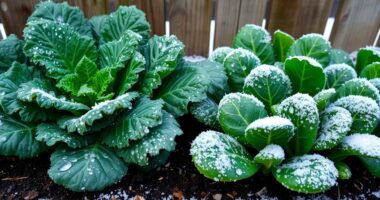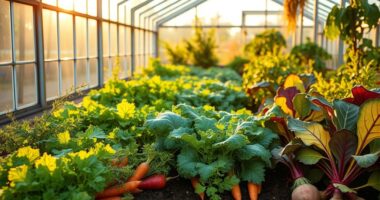To prepare your greenhouse for frost and fall weather, start by improving ventilation to balance humidity and prevent mold while sealing cracks to keep cold out. Use heaters or heat mats to maintain warmth, and cover vulnerable plants with frost cloths or blankets during cold snaps. Regularly clean and inspect for pests, and guarantee proper airflow to curb pests and disease. For more tips on safeguarding your greenhouse this season, keep exploring strategies to stay ahead of the weather.
Key Takeaways
- Install frost covers or blankets to protect sensitive plants during cold snaps.
- Use heaters or heat mats to maintain stable, warm temperatures inside the greenhouse.
- Seal cracks and vents to prevent cold air entry and improve insulation.
- Adjust ventilation to balance airflow, humidity, and heat retention during fall weather.
- Remove debris and pests, and ensure structural integrity to promote a healthy, pest-free environment.

As fall approaches and temperatures drop, it’s vital to prepare your greenhouse to withstand frost and chilly weather. One of the most significant steps is guaranteeing proper ventilation management. As the air cools outside, you need to regulate airflow to prevent excess humidity and condensation, which can promote mold, mildew, and pest problems. During the day, open vents or windows to allow fresh air to circulate and reduce moisture buildup. At night, you may need to partially close or cover vents to retain heat while still allowing some airflow. This balance helps maintain a stable environment, preventing sudden temperature drops that can stress or damage your plants. Proper ventilation also discourages pests, as many insects prefer damp, stagnant conditions. Keeping the air moving prevents pests from settling and reduces the likelihood of infestations. Additionally, using fans or exhaust systems can help improve air circulation and further control humidity levels within the greenhouse.
Alongside ventilation, pest control becomes even more vital as colder weather approaches. Many pests seek shelter inside a greenhouse to escape the cold, making it a perfect breeding ground if not managed carefully. Start by inspecting your plants and the structure itself for signs of pests or entry points. Seal any cracks or gaps around vents, doors, and windows to keep pests out. Consider using physical barriers, such as insect screens on vents and vents covers, especially during high pest activity periods. Regularly monitor your plants for pests like aphids, whiteflies, or spider mites; early detection is key to preventing their populations from exploding during the fall. You can also employ organic pest control methods, like neem oil or insecticidal soaps, which are effective and safe for most plants. Avoid over-watering, as damp conditions attract pests and foster fungal growth, particularly in cooler weather when evaporation slows down.
Additionally, cleaning your greenhouse thoroughly before colder weather sets in helps reduce pest hiding spots and removes plant debris that could harbor pests or diseases. Remove fallen leaves, spent plants, and any clutter that could serve as pest refuges. As you prepare for frost, consider installing heat sources, such as heaters or heat mats, to protect vulnerable plants and maintain a consistent temperature. Covering plants with frost cloths or blankets during cold snaps further shields them from freezing temperatures. Remember, the goal is to create a balanced environment—adequate ventilation prevents excess humidity and pests, while strategic pest control measures keep your plants healthy and thriving through the fall and into winter. With these steps, you’ll guarantee your greenhouse remains a safe, productive space despite the dropping temperatures outside.
Frequently Asked Questions
How Can I Prevent Pests From Entering My Greenhouse During Fall?
To prevent pests from entering your greenhouse during fall, identify and seal all pest entry points like gaps around vents, doors, and vents. Use natural deterrents such as neem oil or garlic spray around these openings to keep pests at bay. Regularly inspect your greenhouse, remove debris, and maintain cleanliness to eliminate hiding spots. These steps will help you effectively block pests and protect your plants throughout the season.
What Are Eco-Friendly Methods to Insulate My Greenhouse?
You can insulate your greenhouse eco-friendly by using compost insulation, which retains heat naturally and enriches your soil at the same time. Additionally, create natural barriers like straw bales or tall plants around the structure to block cold winds. These methods not only keep your greenhouse warm but also reduce energy use, making your setup more sustainable and environmentally friendly.
How Often Should I Check for Mold and Mildew in Fall?
You should check for mold and mildew at least once a week during fall. Regular mildew monitoring helps you catch issues early, preventing mold prevention problems later. Keep an eye on damp spots, ventilation, and plant health. If you notice any signs of mold or mildew, improve airflow and reduce humidity immediately. Consistent inspections guarantee a healthy greenhouse environment and protect your plants from potential damage.
Can I Grow Tropical Plants Safely During Fall in a Greenhouse?
Growing tropical plants in fall is like trying to keep a summer flame alive—possible if you carefully manage fall greenhouse temperature. You can do this by maintaining warm, stable conditions and providing proper tropical plant care. Keep an eye on temperature fluctuations, ensuring they stay within the plants’ comfort zone. With consistent warmth and humidity, your tropical plants can thrive through fall, turning your greenhouse into a lush, tropical oasis.
What Are the Best Practices for Watering During Colder Months?
During colder months, you should adjust your watering schedule to prevent overwatering while ensuring your plants stay healthy. Water only when the top inch of soil feels dry, and do so early in the day to allow excess moisture to evaporate. Practice water conservation by collecting rainwater or reusing greywater, and avoid overhead watering to reduce humidity and disease risk. This balanced approach keeps your greenhouse thriving through winter.
Conclusion
As the season gently whispers its arrival, a little extra care can help your greenhouse dance through the cooler days with grace. By tending to your plants and securing your space, you’re ensuring they’ll weather the change comfortably. Embrace these small preparations—they’re like warm hugs for your green friends, guiding them safely into fall’s embrace. With a little attention, your greenhouse will continue to flourish, ready to greet the changing seasons with renewed energy.









